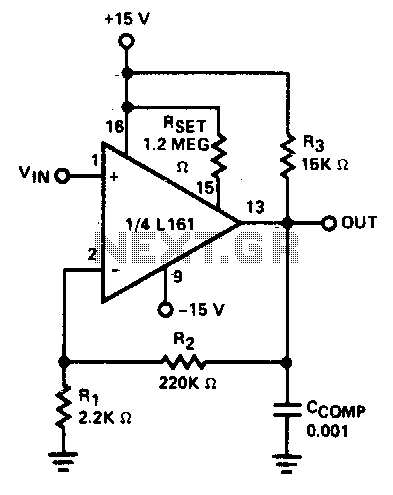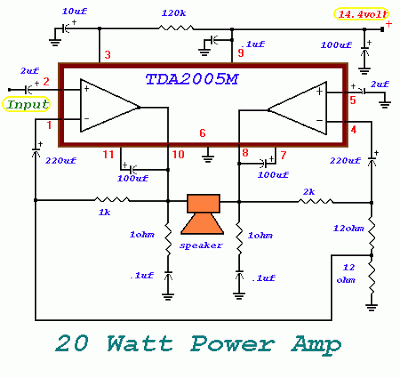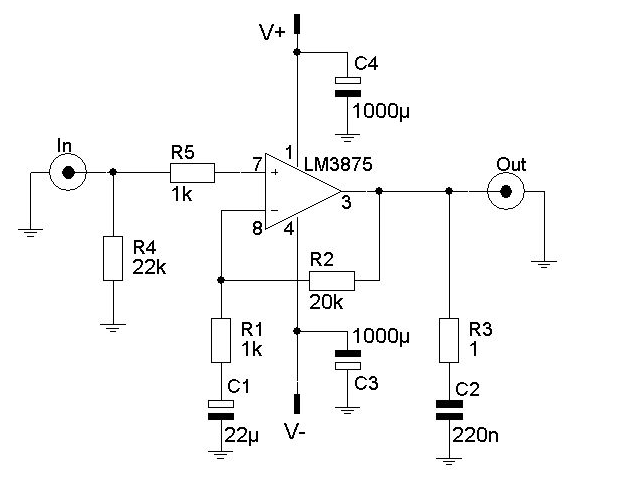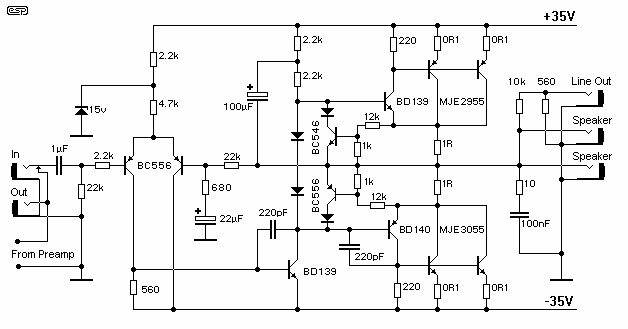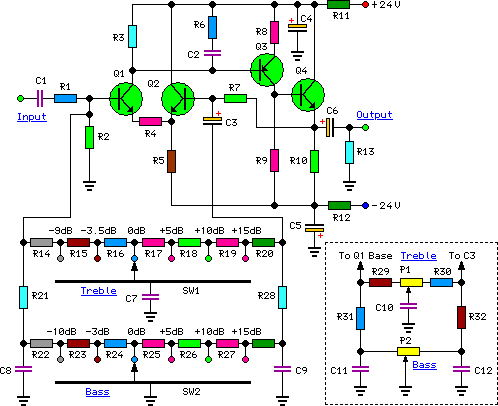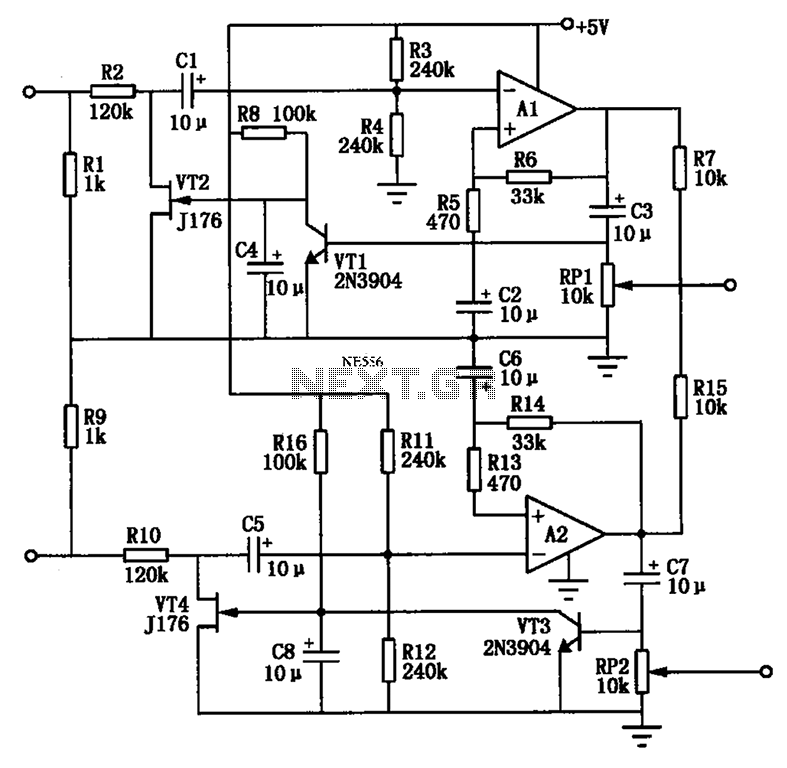
Vertical Deflection Amplifier for Oscilloscope
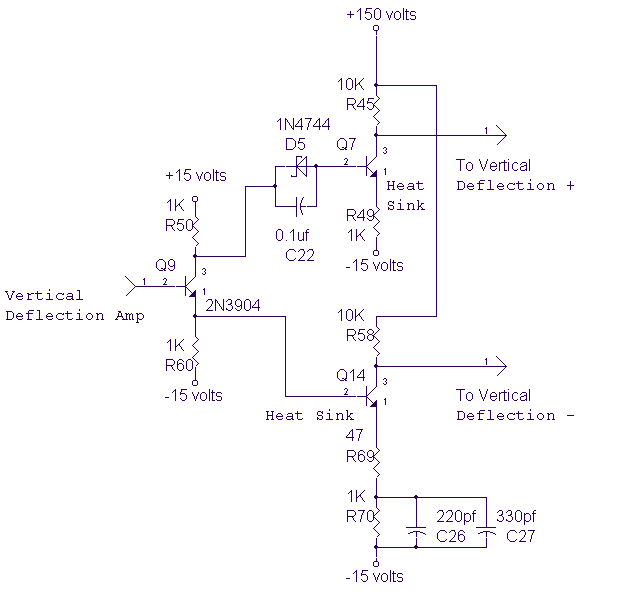
The vertical deflection amplifier uses a 180 degree phase splitter to generate a differential signal. The CRT requires large drive voltages, but almost no current. The oscilloscope bandwidth is limited by the amplifier chain as almost all electrostatic CRTs have a bandwidth extending to several hundred megahertz.
The vertical deflection amplifier circuit is designed to drive the vertical deflection plates of a cathode ray tube (CRT) in an oscilloscope. The primary function of this amplifier is to convert an input signal into a high-voltage differential output that can effectively control the vertical movement of the electron beam within the CRT.
At the core of this circuit is a 180-degree phase splitter, which is typically implemented using a differential amplifier configuration. This component takes a single-ended input signal and produces two output signals that are equal in magnitude but opposite in phase. This differential output is crucial for driving the vertical plates of the CRT, as it allows for precise control of the beam's vertical position without introducing significant noise or distortion.
The CRT requires substantial drive voltages to ensure that the electron beam can traverse the vertical deflection plates effectively. However, it is important to note that the current requirements are minimal, as the deflection plates primarily need sufficient voltage to create an electric field that influences the beam trajectory.
The bandwidth of the oscilloscope is heavily influenced by the characteristics of the amplifier chain. The vertical deflection amplifier must be capable of handling high-frequency signals, as many electrostatic CRTs can operate at bandwidths extending into the hundreds of megahertz. This necessitates careful selection of components within the amplifier chain, including high-speed transistors and capacitors with low parasitic inductance, to minimize signal degradation and maintain fidelity at high frequencies.
In summary, the vertical deflection amplifier is a critical component in oscilloscope design, enabling accurate representation of high-frequency signals on the display by effectively managing voltage levels while keeping current requirements low. The careful design of the amplifier chain is essential to achieve the desired bandwidth and performance characteristics of the oscilloscope.The vertical deflection amplifier uses a 180 degree phase splitter to generate a differential signal. The CRT requires large drive voltages, but almost no current. The oscilloscope bandwidth is limited by the amplifier chain as almost all electrostatic CRTs have a bandwidth extending to several hundred megahertz.
🔗 External reference
The vertical deflection amplifier circuit is designed to drive the vertical deflection plates of a cathode ray tube (CRT) in an oscilloscope. The primary function of this amplifier is to convert an input signal into a high-voltage differential output that can effectively control the vertical movement of the electron beam within the CRT.
At the core of this circuit is a 180-degree phase splitter, which is typically implemented using a differential amplifier configuration. This component takes a single-ended input signal and produces two output signals that are equal in magnitude but opposite in phase. This differential output is crucial for driving the vertical plates of the CRT, as it allows for precise control of the beam's vertical position without introducing significant noise or distortion.
The CRT requires substantial drive voltages to ensure that the electron beam can traverse the vertical deflection plates effectively. However, it is important to note that the current requirements are minimal, as the deflection plates primarily need sufficient voltage to create an electric field that influences the beam trajectory.
The bandwidth of the oscilloscope is heavily influenced by the characteristics of the amplifier chain. The vertical deflection amplifier must be capable of handling high-frequency signals, as many electrostatic CRTs can operate at bandwidths extending into the hundreds of megahertz. This necessitates careful selection of components within the amplifier chain, including high-speed transistors and capacitors with low parasitic inductance, to minimize signal degradation and maintain fidelity at high frequencies.
In summary, the vertical deflection amplifier is a critical component in oscilloscope design, enabling accurate representation of high-frequency signals on the display by effectively managing voltage levels while keeping current requirements low. The careful design of the amplifier chain is essential to achieve the desired bandwidth and performance characteristics of the oscilloscope.The vertical deflection amplifier uses a 180 degree phase splitter to generate a differential signal. The CRT requires large drive voltages, but almost no current. The oscilloscope bandwidth is limited by the amplifier chain as almost all electrostatic CRTs have a bandwidth extending to several hundred megahertz.
🔗 External reference
Warning: include(partials/cookie-banner.php): Failed to open stream: Permission denied in /var/www/html/nextgr/view-circuit.php on line 713
Warning: include(): Failed opening 'partials/cookie-banner.php' for inclusion (include_path='.:/usr/share/php') in /var/www/html/nextgr/view-circuit.php on line 713
